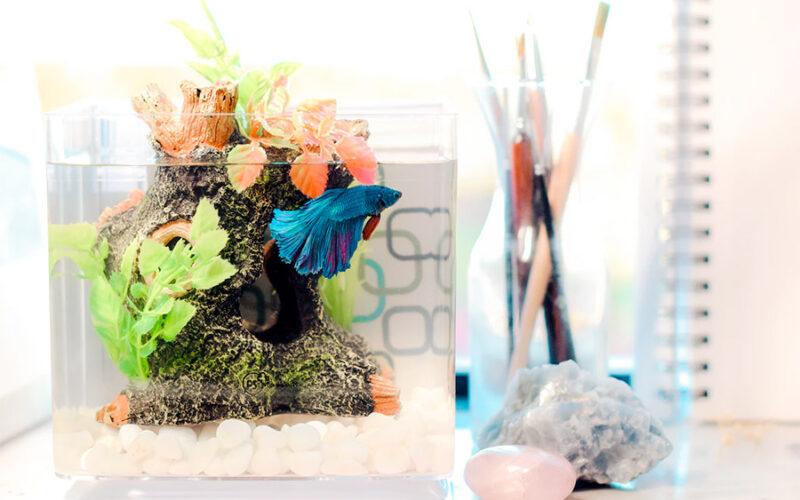Little in size and popular for their beautiful and vibrant coloration, betta fish, or the Siamese fighting fish are some of the most eye-catching freshwater fish that are sensitive and complex individuals. You are more likely to find betta fish living in small bowls that actually provide a bad environment. But many homes or offices use them as colorful decorations that brighten up their space.
Betta fish colors come in huge variety and pattern. The standard red and blue patterns are the most popular as they are easy to breed and inexpensive. One fun fact about these fish is there are still a lot more colors and patterns that breeders have been working on, some of which you may have no clue exist.
Also known as labyrinth fish, betta fish was discovered in Southeast Asia, living in rice paddies, in the shallow water of marshes, drainage ditches, ponds, and the warm flood plains. They have the labyrinth organ that makes them able to adapt in stagnant, oxygen-deficiency water uniquely: directly breath oxygen from the air and take in oxygen from its gills.
Though for short periods, the betta can survive out of water. If needed, they also can inhale the air around. Although they are often seen in a small bowl or plastic, in poor water quality, and can tolerate that kind of environment, bettas live best in at least two gallons size of a small aquarium with regular water changes.
Betta fish, surprisingly, able to recognize their human guardians. This is why you may see them swim excitedly when they see you approaching. These beautiful creatures also have a curiosity that makes them inspect any new items that you put into their tank.
The betta fish colors, patterns, and the shape of their tails are three ways to classify the types. From short and neat to long and flowing, their tails come with a lot of variation, as well as their body patterns, from single to multi-colored patterns.
However, the most striking characteristic of these stunning fish is the color, and they have been bred in all the beautiful colors of the rainbow. All varieties of colors, patterns, and tail shapes combine together, and you will find hundreds of different types available. Surprisingly, none of them are the same.
Types of Betta – Betta Fish Colors
There are a lot of arguments on a simple question like “how many types of betta fish?” If you do online research through reliable sources, you will likely find that the types of betta fish are divided into tail shapes, colors, and patterns.
Let’s talk about color variations. Some of them will have a mix of lots of colors, whereas others might have a solid color. They can be colors of rainbow or butterflies, some will be green, translucent skin, black, electric blue, copper, white, and more.
1. White Betta Fish
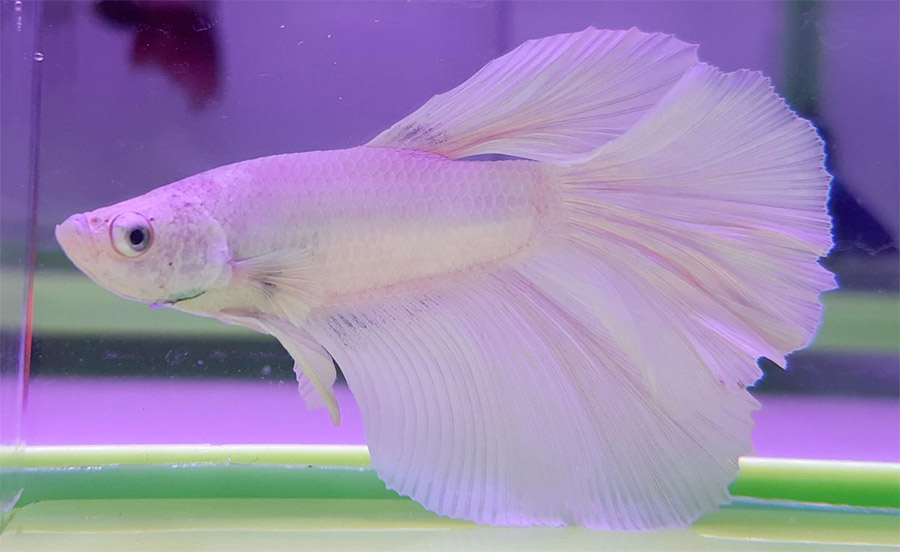
Completely one solid color, that is white. When you compare it to other variations, the white betta fish might appear a bit dull or plain. But worry not, with the right tail shape and type, your betta fish is quite awesome. Long flowing swooping types of tails, for example, will look majestic in white.
2. Clear or Cellophane
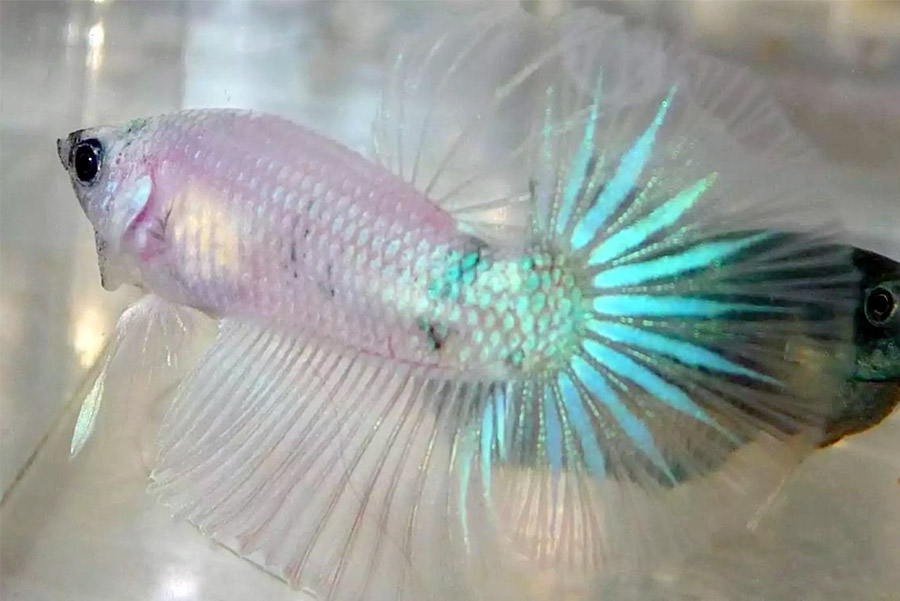
The betta fish with cellophane color has translucent skin and no pigment. They can look colorless without the shine from the inside flesh of the fish through the skin and create a pinkish color. Their tails and fins also have translucent skin.
Often confused with the albino, they have characteristics that the albino type doesn’t have; the black colored eyes.
3. Pink Betta Fish
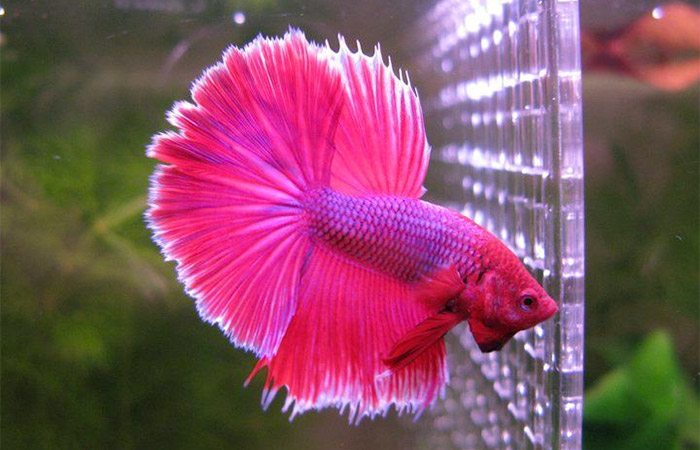
Do not mistake it with the albino variation; the pink betta fish sometimes appear almost transparent or translucent. This unique appearance is due to a lack of pigment combined with the flesh shining through its skin. If you are lucky to find them with a full pink color, your betta fish will have a rich and bright pink color not just on the body but fins too.
However, you may find them most in mixed color variations, from purple, white, and red along their body, tail, and fins.
4. Opaque or Pastels
Technically, opaque or pastel color is just one main color that overlayed by a milky white color. So, there are opaque versions of all colors.
Yellow Betta Fish
Another common color of betta is yellow. The yellow betta fish, also commonly known as ‘non-red’ generally shows a full yellow color extending along the tail and fins, with many different shadings from extremely yellow to a softer tone.
Yellow beta fish variation also comes in the form of darker yellow around the scales. It is called pineapple due to the fish’s appearance being somewhat like the scales of a pineapple.
5. Red Betta Fish
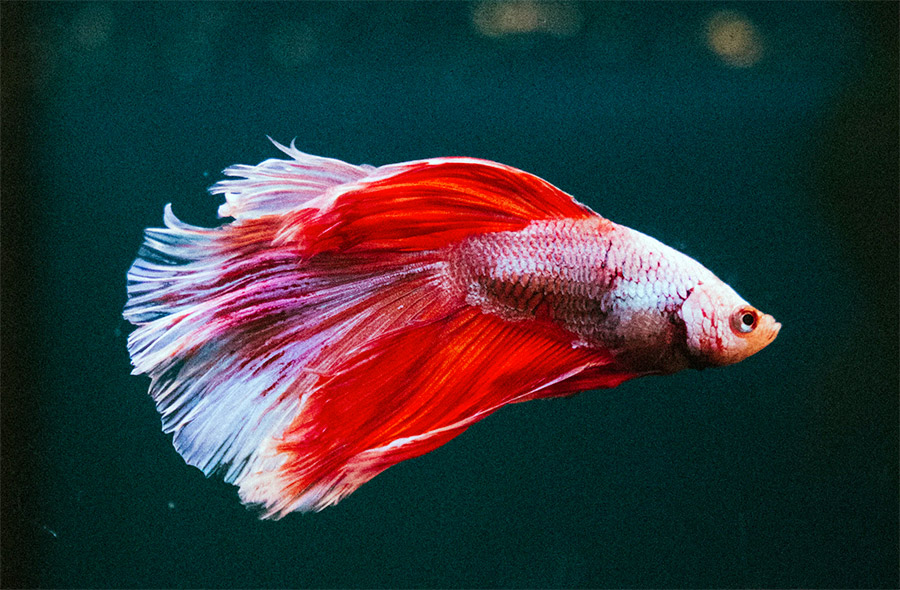
One of the dominant colors of the betta fish is red. It is very commonly seen but still eye-catching and gorgeous. Red betta generally comes in a bright and solid red and also can be found in a “red wash” color variation.
6. Turquoise
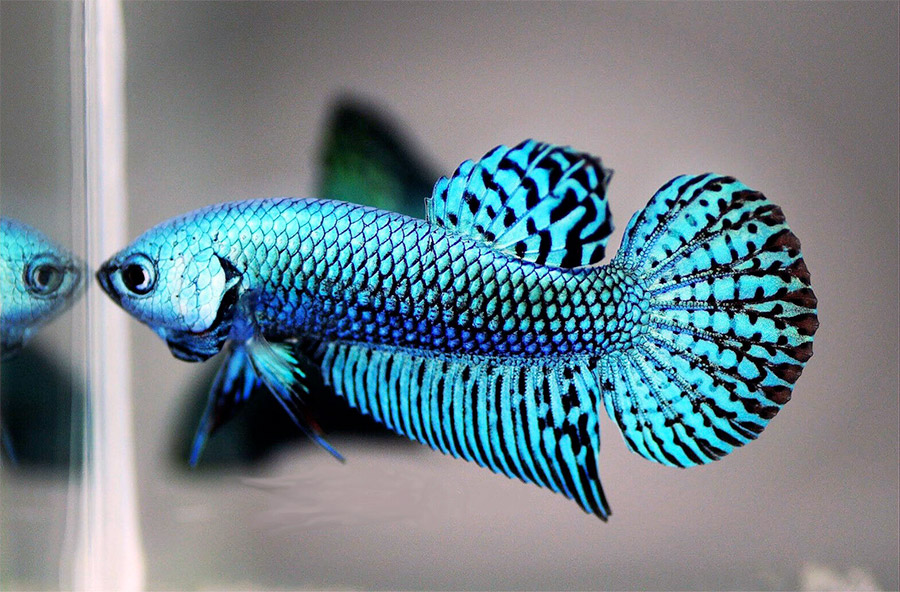
Turquoise betta fish colors are a hard color to define. Some say it is somewhere between blue and green color and can end up looking like a plain green or plain blue in certain light.
Your best way to determine if it’s a turquoise is: you find it too green to be a blue, then when the shining light to it you don’t find any yellow shades at all. If the yellow shade is there, then it’s more likely only green.
7. Black Betta
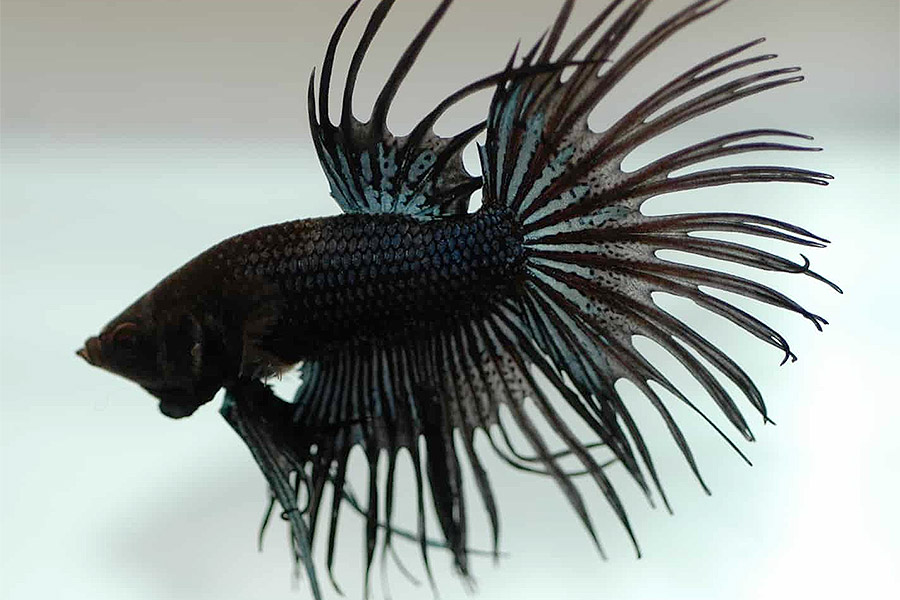
Black betta has three different types:
- Melano. The deepest black and the most popular among the three. This type is plain black, and the females are infertile. This means they can only be bred by the same type of gene.
- Black lace. They have a deep black color, easy to breed, because unlike the melano, the females are fertile.
- Metallic black. More like copper and they have some iridescent scales.
8. Blue
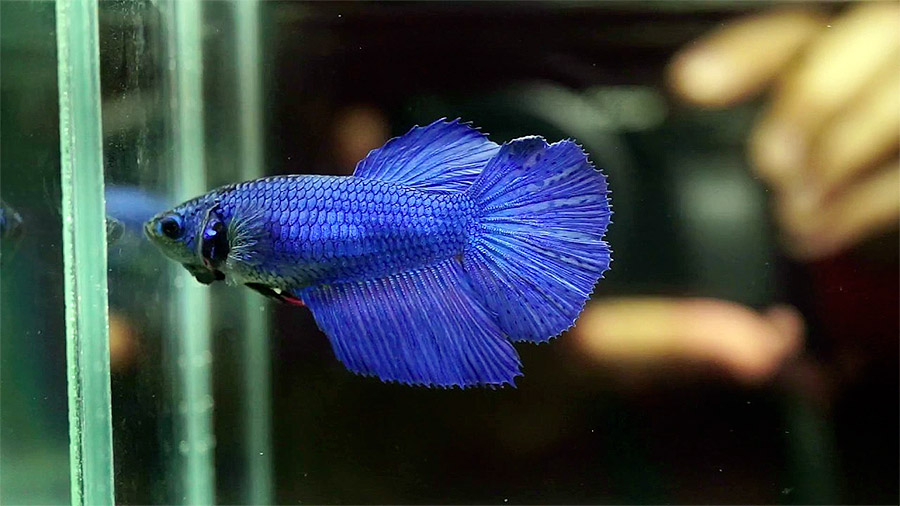
Royal blue and steel blue are several beautiful solid shades of blue in betta fish colors variation. While true blue is also called the “blue wash” type, steel blue is more grayish and colder.
9. Chocolate Betta Fish
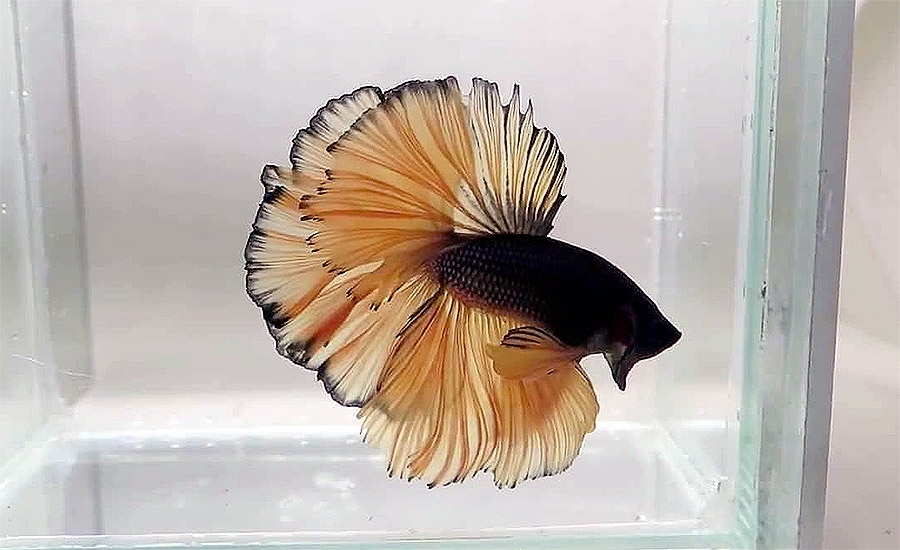
The type of chocolate betta colors commonly refers to a brown colored body of the fish. On the fins, the color mostly comes in orange or yellow. This type is particularly one of the bi-colored varieties.
Rare Betta Fish Colors
Aside from the above common betta fish colors, there are also several rare colors as well. Here are some of them:
1. Albino
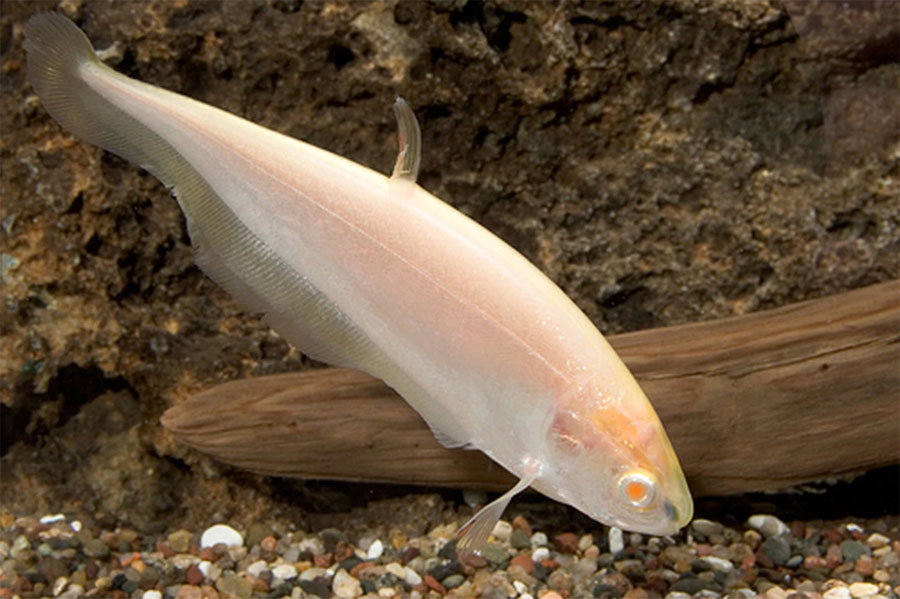
Just like in other species, albinism exists in bettas variation as well. Albino is one of the extremely rare betta fish colors. They are actually a solid white with no pigmentation at all.
They have characteristics of red or pink eyes and blind at a very early age. Note this: if your white betta has black eyes, then it’s not albino.
2. Orange bettas
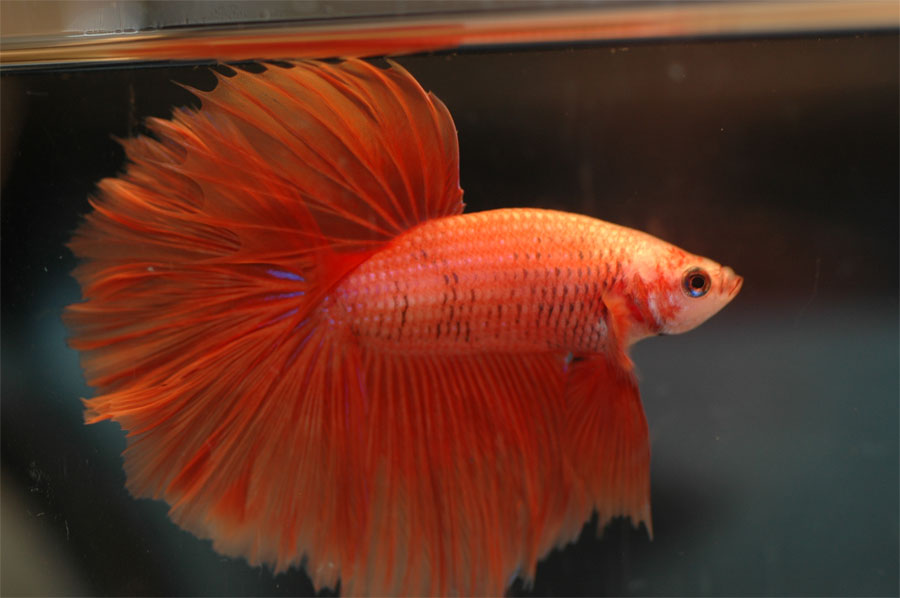
Orange color bettas are quite rare, but once you find them, you will find them in a rich tangerine type shade. Interesting fact: they often look red in bad lighting. You may want decent full and strength illumination to bring out their best color.
3. Purple Betta Fish
Among a huge range of striking colors and numerous eye-catching tail shapes, the purple betta fish is something simple solid color that is prized by aquarists around the world. Even though so, finding the true purple betta is quite challenging. You may often find them most in purple-blueish or violets with other colors variations such as black and copper.
They have all different color patterns and types of tails. Most of them come with purple bodies and another color variation on the face and fins.
4. True green
One of the rare betta fish colors that is rare to see is true green. People somewhat confuse it with turquoise. In fact, it looked just like the other dark-colored fish until you held it up to a torchlight to find the iridescent green shine out. Dark green is a highly prized variety and especially sought after.
5. Mustard gas
Mustard gas is usually confused with chocolate color due to its brown bodies. This color is actually another form of bi-colored varieties where their body generally comes in a dark color like steel blue, green, or blue, along with orange or yellow fins.
6. Grizzle
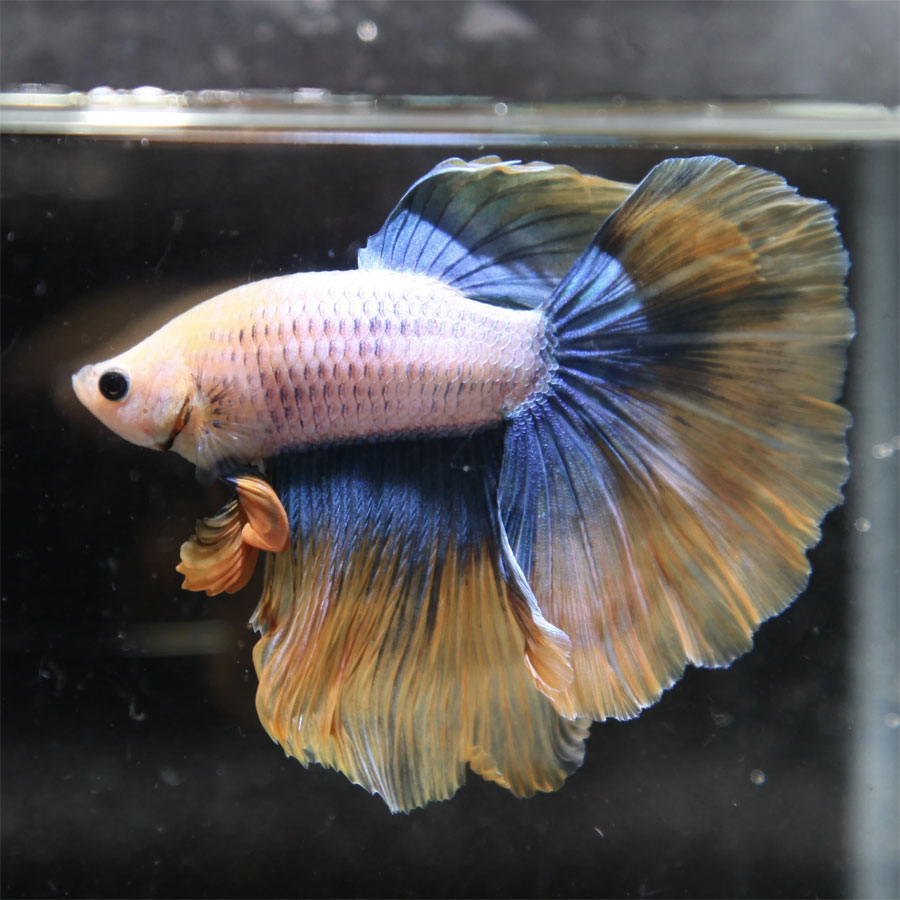
Grizzle is one of the rare betta fish color that consists of two or even more colors that bleed together beautifully. Interestingly, the colors look like they are blended at the edges with a paintbrush.
Types of Betta Fish Pattern
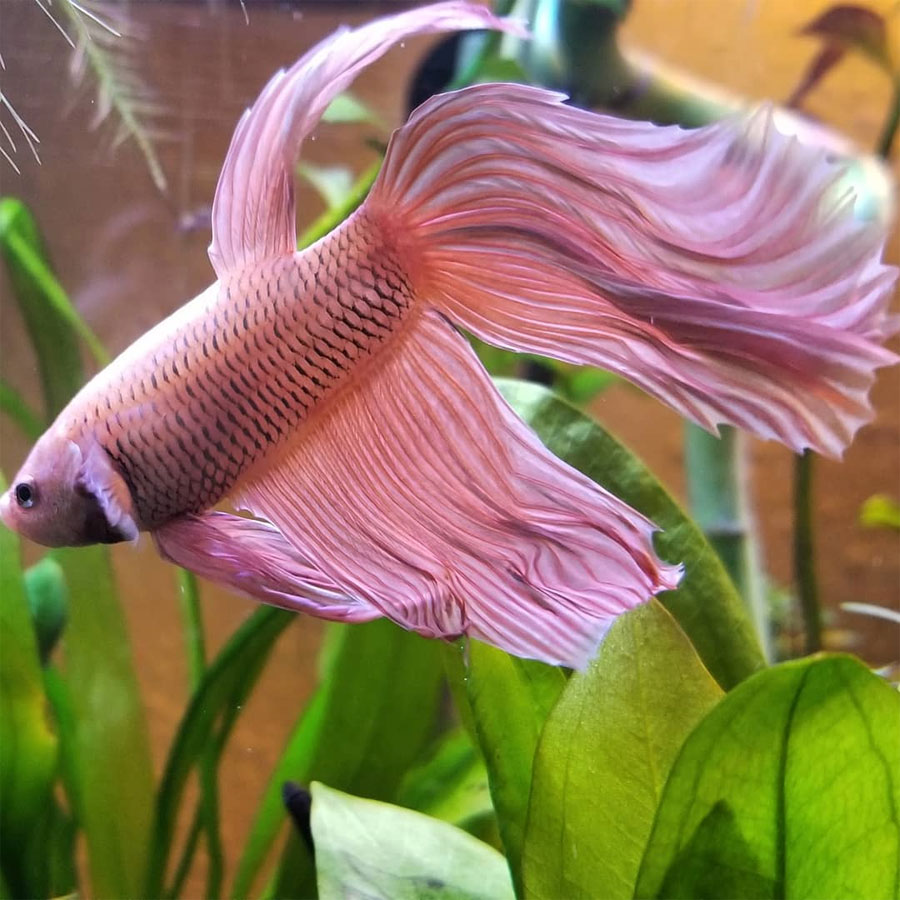
Another factor in distinguishing betta types is identifying the betta fish pattern, including the colors and scales on the fish fins and body. Below are the commonly known patterns:
Bi-colored
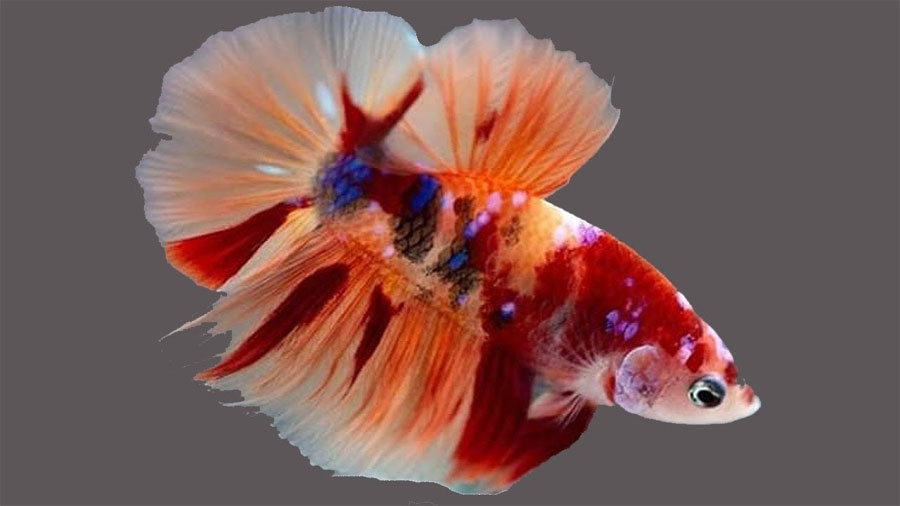
In a simple way, bi-colored betta fish have a body of one main color and another color on the fins. This means that they should only have two colors. There are two varieties accepted to describe this pattern:
- A light bi-colored betta, where the fish body has a light color and dark contrasting colored fins.
- A dark bi-colored betta, where the fish body has a solid color and the fins have either bright contrasting color or translucent.
Butterfly
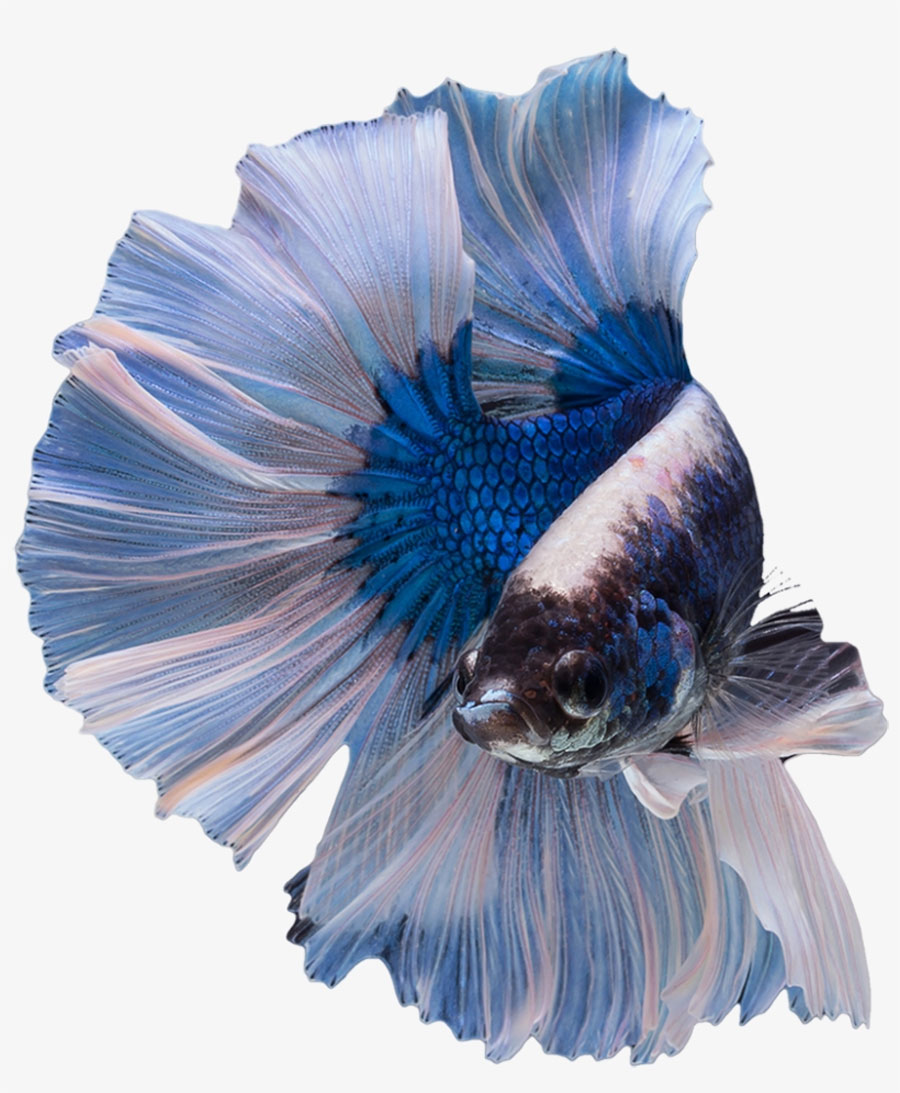
This betta fish pattern shows a single solid color on the body that extends into the fins and stops in a distinct line on the base, leaving the rest of the fins translucent or pale. This way makes the fins beautifully two-tone.
The ideal color split in the fins would be 50/50, half and half between the two tones. But it is rarely found, and some leeway of 20% or so is accepted.
Cambodian
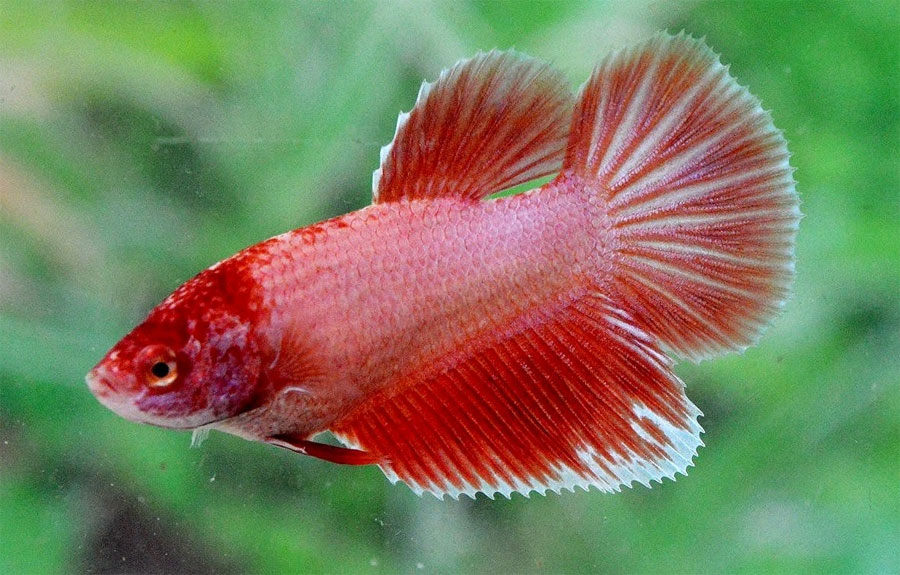
The Cambodian pattern consists of a pale-light pink or white body. While the fins generally come in red and maybe another color as well, with a solid flesh-colored body.
Dragon
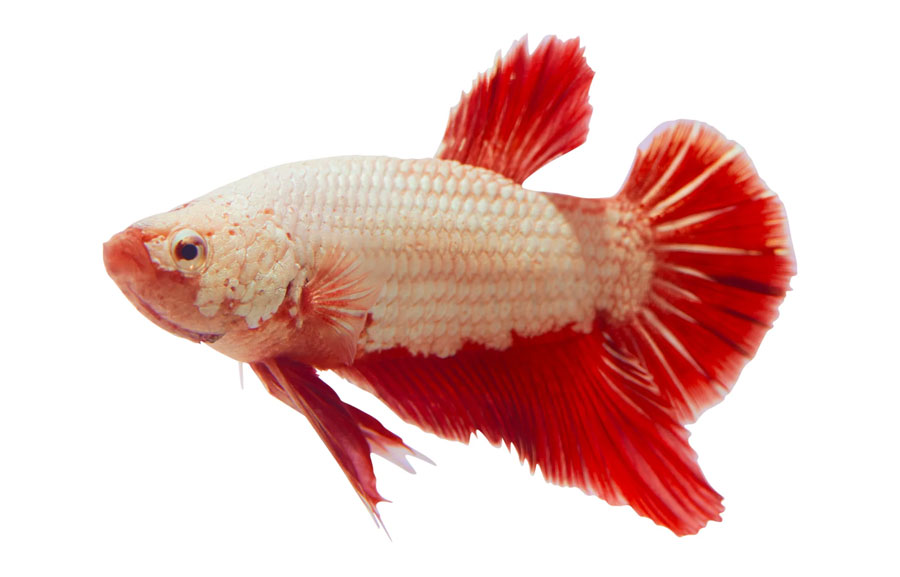
This type of betta fish colors and pattern is relatively new and quite popular due to its super striking appearance. The main idea is it has a rich and bright base color, often red, with thick, opaque white, metallic, or iridescent scales on the body.
The true dragon pattern is not just a thick-scaled fish, but betta fish with metallic, opaque, white, and varied fins. If it does not have all of these traits, then instead classified as a dragon, it is classified as “metallic”.
Marble
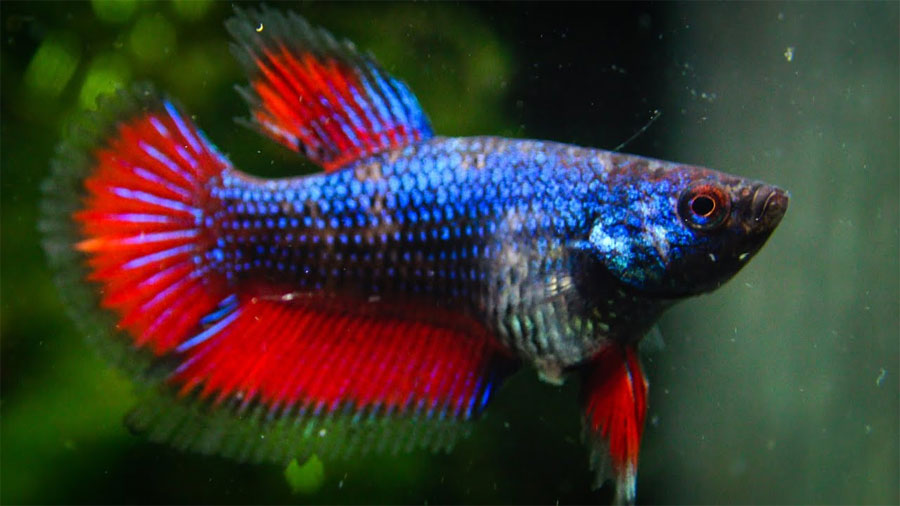
Marble betta fish pattern has irregular splash-like patterning all over the fish body. The base color is usually pale with bold and solid patterns. You can say that all marble bettas should have a marbling body, but not on the fins.
Generally, the fins are translucent, but some of them also show marbling. One interesting fact about marble betta is the patterns can change throughout the fish’s lives.
Mask
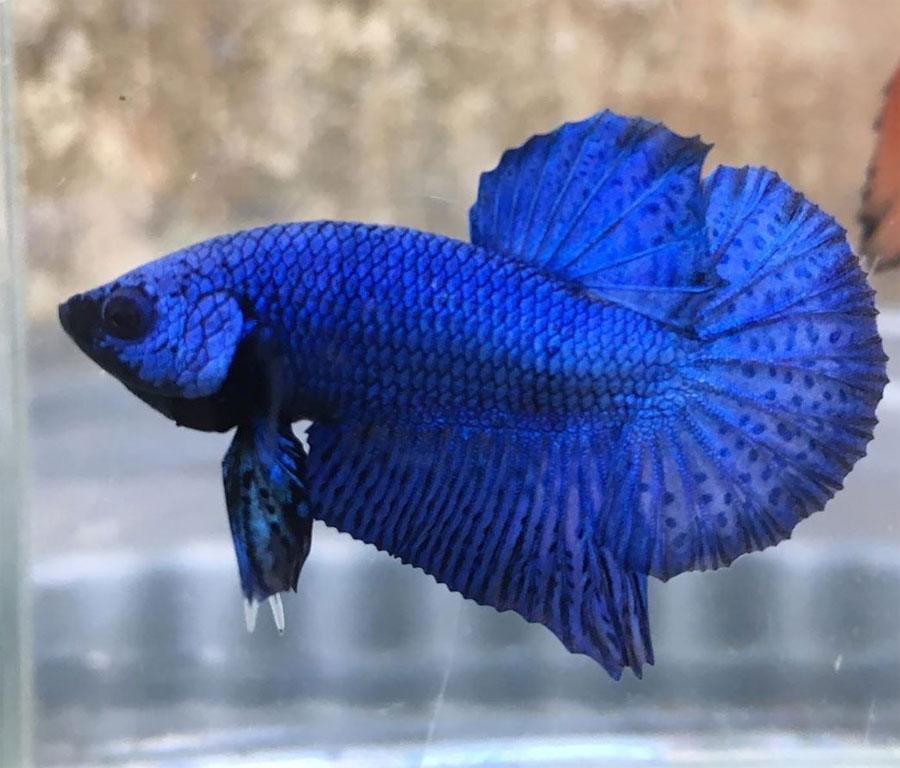
You may not know about this: the betta fish has faces that are naturally darker than other parts of their body. But for mask types, their faces have the exact same shade and color as the rest of the body. You can see the same idea in blue, copper, and turquoise betta fish colors too.
Multicolored
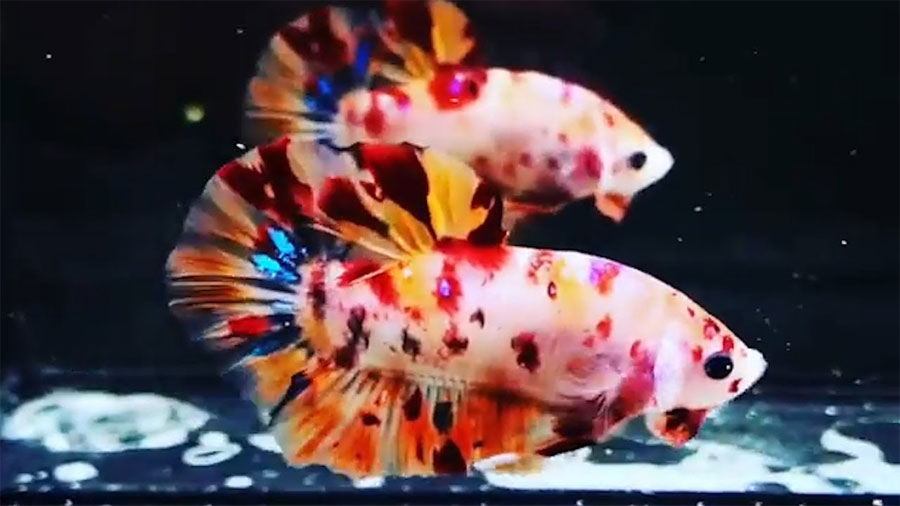
Betta’s MZKR by AquaAma on Youtube )
If the bi-colored betta has only two colors on their body, the multicolored pattern has three or more. There are no strict rules; it applies to a huge number of variations as well.
Piebald
Generally, a piebald betta fish has a pinkish or white, flesh-colored face, along with another color on the body altogether. The body is usually in solid dark color and some slight marbling or even butterfly-like patterning on the fins all at once.
Solid
Exactly as it sounds, a solid betta fish simply has a single solid color all over the body.
Wild Type
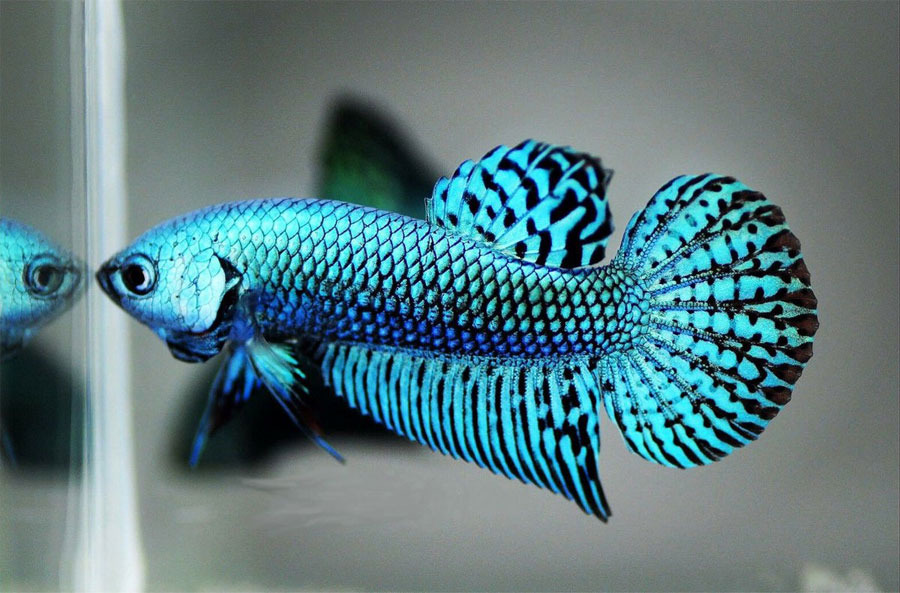
The main characteristic of this pattern is they consist of mostly dull brown or red as the main body color. There will also be some green or iridescent blue scales, and some red and blue in the fins of a male betta.
Betta Fish Colors Care Tips – Brighten Your Bettas
Keep in mind that your betta fish color will not peak until the age of 6 to 8 months, but it will fade naturally along with the age when it reaches about 3 years old. Even so, your betta fish may also become faded and pale for several reasons, even in their prime of life. Follow these tips to brighten your bettas’ colors.
Frequently Check the Water
Although this fancy fish doesn’t need a fancy aquarium setup, within just a couple of days, small bowls, jars, or vases can become toxic with high levels of ammonia. This unhealthy environment can stress your betta fish and cause it to lose its brightness.
Create a comfortable environment for your fish to let its colors shine. The size of the tank should be a minimum of at least 2 gallons, and the ideal temperature accepted is between 78 and 82 Fahrenheit since cold water may suppress the fish’s immune system.
To keep the betta fish colors remain beautiful, you should also pay more attention when cleaning their bowl or tank. Instead of changing the water all at once, it is highly recommended that you take out only a third of the water each time before replacing it with fresh water. This way gently prevents the fish from an upsetting biological environment balance, as well as gently allows them to adjust to the temperature and pH of clean water.
Make sure you clean the bowl or tank every three or four days. These are some tips you can do:
- If you find your water contains a high level of chlorine, use a drop of dechlorination to the tap water before adding it to the tank or bowl.
- Do not use disinfectants or soap to clean off fish decorations because they can harm the fish. Consider using plain warm water instead.
Shrimps for Good
Your betta fish colors need special treatment. Other than a healthy environment, you need to enhance its color by feeding them natural foods with carotenoids. The best source of carotenoids is brine shrimps or other crustaceans. You can easily find them labeled as color-enhancing foods in the fish store.
Now you have probably realized that there are more types of betta fish than you and most people would ever know. Also, betta fish have several tail shapes like a half-moon, crown tail, double tail, veiltail, and short-finned fighting-style tail. Each of them can be combined with betta fish colors and patterns.
